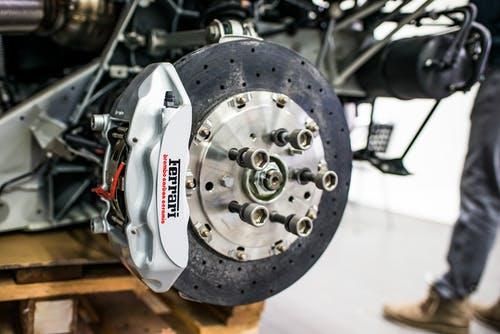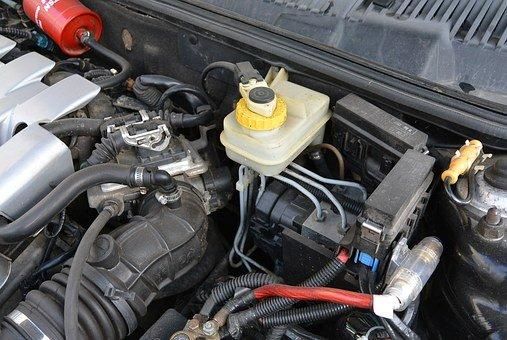
How Car Brakes Work
Featured Image Credit: Capri23auto / Pixabay
By John Linden
Drivers press their car brakes assuming these components will function without flaw yet few give thought to how brakes actually work. Even if you are not an auto mechanic, you can benefit from understanding how car brakes function. Though you might not repair or replace your vehicle’s brakes on your own, it is quite interesting to understand how these essential vehicle components work. Furthermore, an understanding of brake system functionality will help you better understand when something goes wrong. Let’s take a look at the basics of car brakes.
The Basics of Brakes

Featured Image Credit: Joenomias / Pixabay
The majority of modern day vehicleshave brakes on each of the four wheels. These wheels function with a hydraulic system. The brakes along the front of the vehicle are more important than those in the back as the braking process moves the vehicle’s weight forward to the front of the vehicle. The comparable efficiency of disc brakes makes them ideal for the front of the vehicle while the rear wheels often have drum brakes. Certain low-cost and high-performance vehicles have all-disc braking systems.
Brakes in Action
The manner in which auto brakes function is interesting both in terms of physics and design. It is pretty amazing to think about how merely applying pressure with one’s foot to a brake pedal can bring an automobile that weighs several thousand pounds to a stop in seconds. The force applied by the foot is multiplied quite rapidly to bring the vehicle to a halt. Here’s how it works.
When the brake pedal is depressed, the vehicle transmits force directly from the driver’s sneaker to the brakes by way of a fluid. However, the brakes need a force greater than that which could be applied with one’s foot. Therefore, the vehicle must multiply the force of the foot either through the multiplication of the hydraulic force or leverage created with a mechanical advantage. The brake sends the force directly to the tires with the use of friction. The tires also rely on friction to send the force to the road.
Brake Hydraulics
Most modern day vehicles are designed with two hydraulic circuits along with two master cylinders. The use of two cylinders and circuits ensures one will function in the event that the other fails. In certain situations, the circuit will work the brakes along the front while the other works the rear brakes. Alternatively, each circuit can work both the brakes in the front and back. In fact, some brake systems are designed for a single circuit to work all four brakes.
If heavy braking is applied, an abundance of weight will be lifted off the rear wheels while locking, possibly leading to a skid that puts the driver’s life in danger. This is precisely why the brakes in the rear of the vehicle are intentionally made to be less powerful than those in the front of the vehicle. The majority of vehicles are equipped with a pressure-limiting valve that is load-sensitive. This valve closes as heavy braking increases the hydraulic pressure to the extent that might force the back brakes to lock, preventing fluid from moving to them. Thankfully, most of today’s new vehicles are made with highly complex anti-locking systems that apply then release the brakes in a quick, repeated fashion to prevent them from locking.
Friction for Braking

Featured Image Credit: lex-ger-2021617 / Pexels
Friction makes it difficult for one object to move over another object. This process is essential to vehicle brake functionality. The level of force required to move something is in direct proportion to that object’s weight. The more the object weighs, the greater the force necessary to create friction. In the context of auto brakes, friction is created when the brake pad presses against the brake’s spinning disc. The greater the force that presses to the brake pad, the more powerful the stopping force is.
A coefficient of static friction determines the level of force necessary to bring the vehicle to a stop when the two surfaces slide relative to one another. In the context of a car tire, the coefficient dynamic friction is considerably less than the amount of the coefficient of static friction. This means the vehicle tire creates the most traction when the contact patch does not slide relative to the ground below. Traction is significantly reduced when sliding such as in a skid.
The Role of Distance and Diameter in Timely Braking
The distance between the brake pedal and the pivot component of the braking system are of particular importance. If the distance between these two is four times that between the cylinder and pivot, the force applied to the pedal must increase by a multiple of four prior to its transmission to the cylinder. The brake cylinder diameter is also likely to be upwards of three times the pedal cylinder’s diameter. This diameter difference multiplies the force all the more.
Let’s assume the force is multiplied by nine. In total, this system boosts the force of the driver’s foot by a 36 factor. Therefore, if 12 pounds of force area applied to the pedal, 432 pounds are generated as the brake pads are squeezed by the wheels.
What About Brake Fluid Leaks?

Featured Image Credit: IgorShubin / Pixabay
Brake fluid is a hydraulic fluid that transfers force, creating pressure that ultimately enhances braking force.If there is a brake fluid leak and it is fairly slow, there will not be sufficient fluid remaining to fill up the brake cylinder. As a result, the brakes will not work as designed. If the leak is significant, the initial time the brakes are pressed will cause the fluid to leak, spurring total brake failure. However, today’s vehicles have a master cylinder engineered to handle such issues.
Disc Brakes and Drum Brakes
Few people are aware that there are two different types of auto brake systems: drum and disc. Disc brakes are the more efficient of the two. Both types of vehicle brake systems rely on friction to reduce speed. The force applied to the brake pedal is translated to hydraulic pressure that moves through the hydraulic fluid lines directly to the wheels, causing the brake shoes to press against the drum brakes.
If the brake system is a disc system, the pressure moves through the fluid lines, reaches the wheels and causes the disc pads to press against the brake rotors. The ensuing fiction reduces wheel rotation in relation to the level of force applied to the pedal. Though the nuances of each braking system are certainly unique, both rely on friction that converts the wheel movement’s kinetic energy into the heat of thermal energy.
Modern Vehicles’ Anti-lock Braking Systems
New vehicles are equipped with anti-lock braking systems or ABS for short. This is an automated system that stops the wheels from stopping their rotation and subsequently skidding. ABS enhances control and reduces stopping distances on both slick and dry surfaces. This system is designed so the driver does not have to pump the brakes. Rather, the driver merely needs to press the brakes with considerable force, leave the foot on the pedal and let the system work its magic. Brakes do not Last Forever
Your brakes will eventually endure wear and tear to the level that they require replacement. It is a mistake to let your brakes wear down to the level that metal presses against metal. Once this occurs, replacing the brake drum or rotor will prove quite expensive. This is precisely why you should have a brake inspection conducted as soon as you notice any indication of wear. If you notice your vehicle pulls to the side when you press the brakes, it is cause for concern.
Additional signs of brake wear and tear include:
- Squeaking noises
- A mushy feeling
- Pulsation and/or shaking
- Odd odors
- The need to add brake fluid at a high frequency
Furthermore, if your brake light illuminates, it is a sign there is a significant problem with the hydraulics. Bring your vehicle to a mechanic for an inspection as soon as possible after the brake warning light illuminates.
What about the Mechanical Handbrake?
The mechanical handbrake functions on the vehicle’s shoes through an intricate mechanical system. This system is distinct from the hydraulic cylinder, featuring an arm and a level within the brake drum, operated with a cable stemming from the handbrake lever. The handbrake applies braking pressure to two of the vehicle’s wheels, typically those in the rear. This brake allows for limited brakingin the event that the hydraulic system no longer functions. However, the primary reason for the existence of a handbrake is its use as a parking brake.
Here’s how the handbrake works. The level within the handbrake pulls the cable or multiple cables connected to the brakes with a set of diminutive levers and pulleys. The handbrake lever’s ratchet ensures the brake is on after it is applied. The ratchet is disengaged with a push-button, ultimately freeing the lever. Handbrakes are complex to the point that they are designed to press the linings of the brake against the drums to ensure a quick and full stop.
Learn More:
https://auto.howstuffworks.com/auto-parts/brakes/brake-types/brake.htm
https://www.carbibles.com/guide-to-car-brakes/
https://www.howacarworks.com/basics/how-the-braking-system-works
https://www.mysynchrony.com/resources/car-brakes.html
https://en.wikipedia.org/wiki/Brake?intcmp=carcare-pagena-article-data_reason-external
https://wonderopolis.org/wonder/how-do-car-brakes-work
https://www.autoguide.com/auto-news/2019/04/how-do-car-brakes-work-.html
https://www.artofmanliness.com/articles/how-car-brakes-work/
https://haynes.com/en-us/tips-tutorials/how-do-car-brakes-work
Updated